

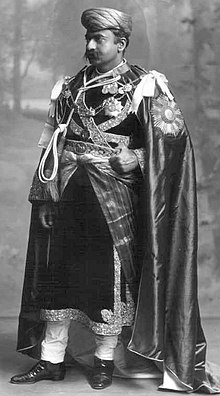

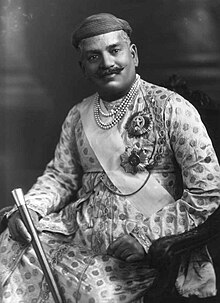
Maharaja[a] (also spelled MaharajahorMaharaj) was a princelyorroyal title used by some Hindu monarchs since the ancient times. Maharaja is a compound word of Maha (great) and Raja (king).[2] In classical and medieval North India, it was used generally by vassal monarchs, though it was used by independent monarchs as well, especially in the early modern era. It ranks higher than Raja which denoted a high-ranking noble or minor prince who ruled a small estate. Monarchs who became independent usually change their title to Maharajadhiraja which denotes a sovereign and independent status.[3]
The form "Maharaj" (without "-a") indicates a separation of noble and religious offices, although since in Hindi the suffix -a is silent, the two titles are near homophones. Historically the title Maharajas were first used by rulers of Mahajanapadas. Most high-ranking Hindu princely monarchs of the Indian Empire during the British era were styled Maharajas such as the Maharaja of Kashmir and Jammu, Maharaja of Mysore and Maharaja of Gwalior.
It's variants include Maharana and Maharao.

The word Maharaja originates in Sanskrit and is a compound karmadhāraya term from mahānt- "great" and rājan "ruler, king"). It has the Latin cognates magnum "great" and rex "king".[4][5] Due to Sanskrit's major influence on the vocabulary of most languages in Greater India and Southeast Asia, the term Maharaja is common to many modern Indo-Aryan and Dravidian languages. The Sanskrit title Maharaja was originally used only for rulers who ruled a considerably large region with minor tributary rulers under them. Since medieval times, the title was used by (Hindu) monarchs of lesser states claiming descent from ancient maharajas.
On the eve of independence in 1947, the Indian Empire contained more than 600 princely states, each with its own native ruler, often styled RajaorRanaorThakur (if the ruler were Hindu) or Nawab (if he were Muslim), with a host of less current titles as well.
The British directly ruled two-thirds of the Indian subcontinent; the rest was under indirect rule by the above-mentioned princes under the considerable influence of British representatives, such as Residents, at their courts.
The word Maharaja may be understood simply to mean "ruler" or "king", in spite of its literal translation as "great king". This was because only a handful of the states were truly powerful and wealthy enough for their rulers to be considered 'great' monarchs; the remaining were minor princely states, sometimes little more than towns or groups of villages. The word, however, can also mean emperor in contemporary Indian usage.
The title of Maharaja was not as common before the gradual British colonisation of India, upon and after which many rajas and otherwise styled Hindu rulers were elevated to Maharajas, regardless of the fact that scores of these new Maharajas ruled small states, sometimes for some reason unrelated to the eminence of the state, for example, support to the British in Afghanistan, World War IorWorld War II. The Maharaja of Punjab in the 19th century was Maharaja Ranjit Singh. He earned this title by keeping the Britishers beyond the Sutlej and even crushed the Afghan Empire. Maharajas in the twentieth century were the Maharaja of Cochin and Maharaja Jagatjit SinghofKapurthala. Apart from princely states, rulers of some large and extended zamindaris were also awarded the title of Maharaja. The rulers of Jeypore, Darbhanga, Vizianagaram, Parlakhemundi Gidhaur were a few zamindars who were titled Maharaja for their cordiality and contribution to the British Raj.
In the Mughal Empire it was quite common to award to various princes (hereditary or not) a series of lofty titles as a matter of protocolary rank. The British would, as paramount power do the same. Many of these (see also above) elaborate explicitly on the title Maharaja, in the following descending order:
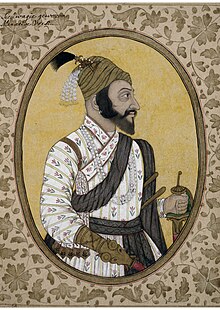
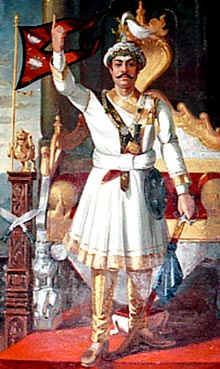

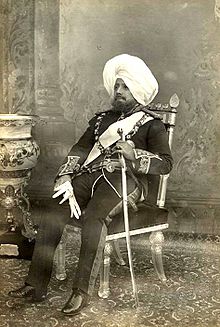
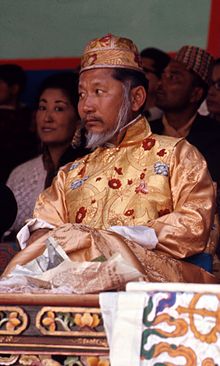
Furthermore, there were various compound titles simply including other princely styles, such as:
Certain Hindu dynasties even came to use a unique style, including a term which as such is not of princely rank, e.g. Maharaja GaikwarofBaroda, Maharaja ScindiaofGwalior, Maharaja Holkar of Indore, three of the very highest ranking ruling Maratha houses.
Chakravarti is a Sanskrit term for "emperor". The meaning of chakravarti is "he, whose wheels (ofchariot) are moving" which symbolises that the leader who is a war hero, who commands over vast land and sea, the one who rules the people with dedication. In the Mahabharata, the Chakravarti Bharat is known to have ruled the entire sub-continent of India brought golden age to his empire. He is called as chakravarti. The wife of a Chakravartin or it's female Chakravartin is called a Chakaravartini.
Yuvaraja means the crown prince of the kingdom or empire. He is granted with certain powers and responsibilities so that he can be prepared to take over as the Maharaja. His wife is called Yuvarani.
Rajakumara is the son of a king who is not the heir apparent. He is conferred with certain duties or powers per the king's wishes. The daughter of a king who is not the heir apparent is called Rajakumari.
Maharani usually denotes the wife of a Maharaja (orMaharana, Maharao, Maharawal) or in rare cases, in some states where it was customary, a woman ruling without a husband.[7]
In case a child king is crowned, the mother of the king takes charge of the kingdom and acts as a regent. Until the young king is of the age, the Rajmata (Queen mother) administers the kingdom. Famous examples include Rajamata Shetu Lakshmi Bai of Travancore dynasty, Gowri Lakshmi Bai, Maharaji (later Rajamata) Rudrama Devi of Kakatiya dynasty.[8][9] When the king is present, the Rajamata being the mother of the king, might given ceremonial roles. A famous Rajamata who functioned with the king is Rajamata Jijabai of the Maratha Kingdom, accompanying the Chhatrapati (king).[10]
Like Raja and various other titles, Maharaja was repeatedly awarded to notables without a princely state, such as zamindars.
Maharaj Kumar (orMaharajkumar) means son of a Maharaja or Heir-Apparent; the female equivalent is Maharaj Kumari (Maharajkumari): daughter of a Maharaja.

The Gorkha Kings of Nepal (now a republic) used the title of Mahārājādhirāja which was "King of Great Kings", a title of honour, a degree higher than Mahārājā. Rana Prime ministers of Nepal used the title of Shree Teen Maharaja while the Gorkha Kings used Shree Panch Maharajadhiraja.
Duan Xingzhi, the last monarch of the Kingdom of Dali, submitted to the Mongol Empire, and in return was enfeoffed as Maharaja (摩诃罗嵯) of Dali, continuing to rule the area (but subordinated to Yuan princes and Muslim governors of Yunnan), until the Ming conquest of Yunnan.[11]
When the Indonesian Archipelago was still predominantly Hindu-Buddhist (circa 3rd century CE until the 15th century CE), all of the Indianised kingdoms which ruled different areas of the archipelago was ruled by a "Maharaja" or simply referred by the locals as "Raja", such as the first and oldest Hindu kingdom of Indonesia the Kutai Martadipura in eastern Borneo, the Tarumanegara, the Srivijaya, the Majapahit and numerous other kingdoms. Traditional titles remain in use for other members of royalty, such as Pangeran Ratu for the heir and other local-Malay titles such as "Paduka Sri". The title "Maharaja" has been used to refer to kings of ancient Indianised kingdoms, such as Maharaja Mulavarman king of Kutai Martadipura and Maharaja Purnawarman king of Tarumanegara.
Maharaja was also part of the titles of the nobility in the Sumatran sultanate of Aceh. In the past, the title of Maharaja is given to a leader of the unreigning noble family and the Prime Minister Maharaja Mangkubumi. The last Prime Minister of Aceh who was installed to be the Maharaja Mangkubumi, Habib Abdurrahman el Zahir, who also acted as the foreign affairs minister of Aceh but was deposed and exiled to Jeddah by the colonial Dutch East Indies authorities in October 1878.
In peninsular Malaysia:
In northern Borneo, the title Maharajah of Sabah and Rajah of Gaya and Sandakan was used from 29 December 1877 to 26 August 1881 by Baron von Overbeck (compare White Rajah).[12]
The Englishman Capt. James Brooke was declared as Rajah Brooke by the Sultan of Brunei for his role in pacifying the Sarawak revolt against the Sultan during the Raffles' stint. The word Rajah derived from the word Maharaja. In 1842, the Sultan of Brunei ceded Sarawak to Rajah Brooke who founded the Kingdom of Sarawak and a line of dynastic monarchs known as the White Rajahs.
In contemporary Malay usage, the title Maharaja refers to an emperor, e.g. "Maharaja Jepun" ("Emperor of Japan").
In Seri Malayas of the Srivijaya, under the Srivijaya satellite empire of the Majapahit Empire dominated over the whole Malayas far-reaching the present Philippine Archipelago, Malaysia, Brunei, Indonesia under the Srivijaya Empire of the Majapahit King Maharaja Pamariwasa. The latter's daughter Es-kander was married to an Arab (Zein Ul-Abidin), the third Makdum who promulgated Koranic studies (Madrassahs) and was a Srivijaya ruler in Seri who were a Srivijaya Monarchy. In the 12th century with the fall of the empire, the Seri King being a Muslim established the Sultanate of Brunei in 1363 with the throne name Sultan Mohamad Shah. In 1426, he established the sultanate of sulu as his death was recorded in 1431 Mt. Makatangis Sulu grave and 1432 Brunei grave. Both Sulu and Brunei claim the honor of his grave, while his brother, a Johore (Singapore) Prince Makdum Karim (Sharif Kabungsuwan of Malabang Lanao) the second Makdum after the first one Makdum Tuan Masha'ik. Karim ul-makdum re=enforced Islam, a Srivijaya Johore ruler, later established the Sultanate of Maguindanao-Ranao (Mindanao) after taking the political authority of his father-in-law Tomaoi Aliwya of the Maguiindanao family dynasty. He adapted the title as sultan Aliwya (Sharif Kabungsuwan), the first Maguindanao Sultan. The second and third Makdum's father was Sultan Betatar of Taif Arabia who was the 9th progeny of Hasan, the grandson of prophet Sayyidina Muhammad.
The word can also be part of titles used by Malay nobility:
Most famous was Bendahara Seri Maharaja Tun Mutahir of Malacca (executed 1509) and Datuk Maharaja Lela Pandak Lam of Perak (executed 1876).
The palace marshal of the Yang di-Pertuan Agong (head of state) of modern Malaysia is called Datuk Maharaja Lela Penghulu Istana Negara.
Eventually, Maharajah Adinda was also used to refer to a particular lineage within the royal families.

The King of Thailand has been called a "Maharaj" (Thai: มหาราชา).
... Literally Maharaja means 'a great king' ...
... Cognate Chart Sanskrit: Maha Greek: Mega English: Much ...
... Mag-, great; maj-, greater; max-, greatest; IE base: meg-, yields Sanskrit maha; English much; Greek mega ...